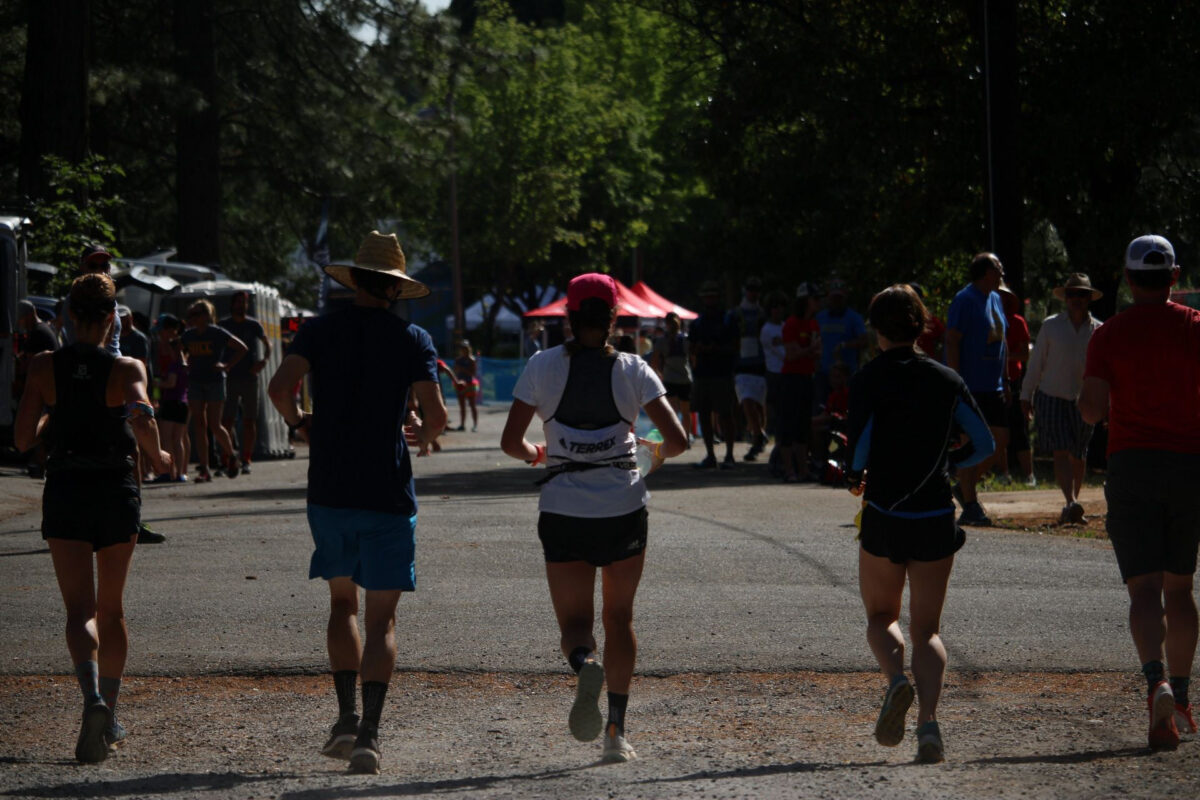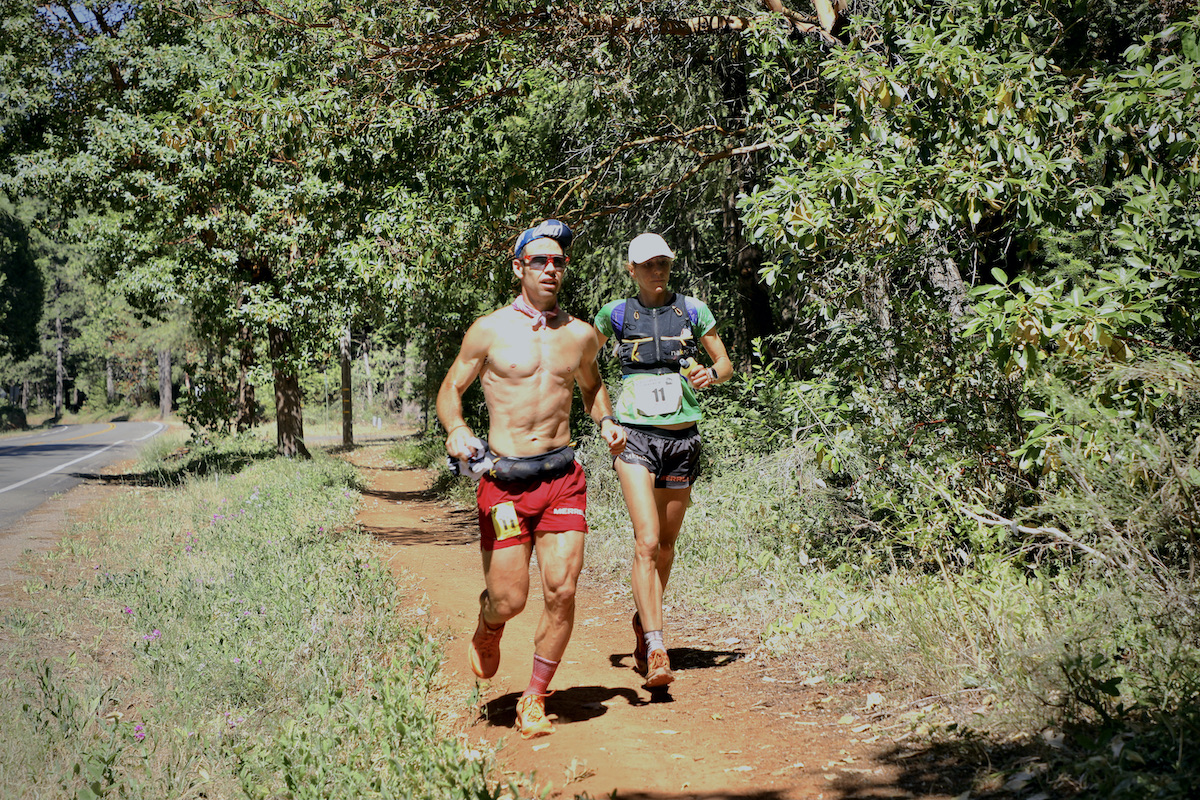Before I ever ran my first 100-mile race, I a good friend invited me to crew and pace her at the 2017 Western States 100. Another friend would help her cover miles 62-80 and then I would accompany her from there to the finish, a team with one mission: get her to the finish strong. The use of pacers is a uniquely North American ultramarathon luxury, and their use is a little contentious. This does mean there are strict rules around pacer use, and unlike in a supported run amongst friends or a Fastest Known Time attempt, pacers in the majority of ultras (excluding the Leadville Trail 100 Mile where pacers are allowed to physically mule the supplies of their runner) are simply there for accompaniment and safety of the runner.

The author (center) runs with a pacer at the 2019 Western States 100. Photo: Thomas Malcolm
However, any pacer worth their salt knows the job of navigating a runner’s emotional needs and psychological state in the back half of a long race can have a profoundly positive impact on a racer’s day. So while they can’t physically mule for you, good emotional muling can pull the very best out of you – physically and psychologically. While no research I’m aware of has been done on the effect of pacers on ultramarathon performance, we can turn to the literature on pace setters in track and marathon running, as well as the strategic use of teammates in multiple sports to explore the physiological and psychological benefit of working with a planned pacer or simply working together with other runners.
Does Pacing Offer Physiological Benefits?
Enter the sub-two-hour marathon project, a racing event contrived to set up a small group of athletes with all possible advantages in hopes that one of them can break a time thought to be impossible. True to form, physiology researchers set out to quantify anything and everything possible to increase performance required for running under the two-hour mark . When you are trying to run a time 2.5% faster than the world record, and you have extensive sponsor support devoted to the cause, you pick apart every component that may reduce the metabolic cost of running. This includes obvious characters like shoe technology, leg swing, and favorable meteorological conditions, but it also includes less conventional things like employing a cooperative drafting strategy. Drafting strategies usually employ a handful of runners, often set up in a chevron, at the front of a group of performers to “break the wind” easing the effort of those behind them. Another cooperative drafting strategy is to do the same thing with a group of racers: each takes a turn aiding the others by running at the front. These strategies are harder to implement outside a controlled lab setting but in an ideal scenario, if a runner could draft completely behind another runner the metabolic cost of running could be reduced by 5.9% (1). That’s a huge benefit if executed correctly.
If you’ve watched well known road marathons, you’ll notice that pacers are often employed early in the race and when they fall off the pace the lead runners are left on their own to fight to the finish. But more critically, if you look closer, you’ll notice the elite runners are often not running in a position that benefits from drafting, and instead often run in between the pacers or even at their shoulder. So if they are not benefiting from the reduction in metabolic cost why have pacers? Enter emotional muling, and the incredibly interesting psychological benefits of utilizing pacers.
Pacers Lighten the Psychological Load
If you remember back to our article on the science of self-efficacy, and the belief in one’s abilities to achieve goals and tasks, you might remember that seeing others complete a goal can build strength in your own belief that you too can complete it (2). Pacers in that sense are the in-race reminder of, “Hey, you got this!” This allows pacers to serve a dual psychological purpose, specifically reducing the mental effort required to both set and monitor a difficult to maintain pace (3). We also see this in grand tour cycling competitions where teams utilize multiple riders to help and protect their top contender in the overall standings through long climbing stages. While this is partially beneficial due to drafting, they have also found that having a teammate lead you on a climb shifts your focus from internal sensory monitoring to external elements which can distract you from perceiving the effort as more difficult (4). Essentially, you stay more in the moment instead of trapped in your own head, wading through discomfort alone. The same is seen in 1,600-meter runners utilizing a pacesetter on the track, where although performance outcomes didn’t change, when asked, the runners thought they had run faster and felt the effort was easier when running with a pacesetter than while running solo (2).

Mike Acer finishes the 2021 Western States 100 with the support of his pacer and crew. Photo: iRunFar
Working Together Helps Everyone
What if you don’t have a pacer or a teammate to be your psychological tugboat?
Have you ever felt like suffering through a long run or workout is a whole lot easier with friends? There’s a reason for that. It turns out working hard with others, be it competitors or teammates, both elevates your pain threshold (5) and modulates your affective feelings (how much pleasure or displeasure it brings) (6).
In a study utilizing University of Oxford rowers, researchers found that when athletes performed ergometer workouts together rather than alone, they displayed an increased pain threshold post-workout (5). You might think they were just putting on a good face for their teammates, and if the pain-threshold component had been tested in view of one another, maybe that would factor in. However, these data points were collected privately approximately five minutes after the end of the workout by inflating blood-pressure cuffs on the athletes’ arms. This effect is owed to something called behavioral synchrony, or coordinated collective action, which results in greater endogenous opioid production (the endorphins and natural pain killers your body produces) than can be produced during solo exercise.
A more recent study conducted with runners in two 10-kilometer time trials highlighted similar results (6). Perhaps not surprisingly, the group of runners ran faster during their group time trial than during their solo efforts, averaging a time of 39:32 together versus 40:28 solo. So what accounts for this increase in performance outside of the obvious push of a competitor? During the study, researchers recorded rate of perceived exertion (RPE), pace, and affective feeling (a point scale of displeasure/negative versus please/positive towards the effort, -5 to +5) each lap. What they found, was even though the runners were running faster during the group time trial the linear RPE progression over the course of the 10k were virtually identical to the solo efforts. Additionally, the pacing strategy played out the exact same in both 10ks, with a fast start, a slower middle, and an acceleration to the end. So the piece of data that stands out suddenly is how the runners felt emotionally over the course of the time trial (negative versus positive affective feelings). A distinct pattern appeared in which the solo time trial runners experienced increasingly negative feelings as the 10k progressed while during the group time trial the runners emotional state remained relatively stable over the entirety of the run (6). This means that even though both runs were hard (similar RPE response), the group time trial felt good by comparison.
We should note that this response still varies amongst individuals and is highlighted by the fact that all 14 of the runners finished the solo time trial while three of the runners dropped out of the group time trial. These runners dropped out not because their perceived exertion was too high (it was the same as their solo effort) but their affective feelings/emotional states were three to five points more negative than expected for a group effort. The run didn’t feel harder, but the negative feelings about the run ultimately won out.

Ragna Debats runs with a pacer during the 2021 Western States 100. Photo: iRunFar
The Takeaways on Pacers
So how can we utilize this information in trail running and ultrarunning?
- Be a positive pacer. While you can’t physically carry anything for your runner, being an emotional mule for your runner is possible. Strengthen your runner’s self-efficacy with reinsuring comments, lead by example (put on a good face), and do as the pro road cycling teams do and be the external leader they need instead of the internal voice.
- Make new teammates in the race. We can line up as competitors, or we can align as teammates. Working with those around you in the race to lighten exertion might be the biggest advantage you can give yourself.
- It can be difficult without being bad. There’s a quote from Dan Millman’s book Way of the Peaceful Warrior that has stuck with me since high school. “Pain is a relatively objective, physical phenomenon; suffering is our psychological resistance to what happens. Events may create physical pain, but they do not in themselves create suffering. Resistance creates suffering.” Akin to what they found in the 10k group time trial study, things can be difficult without feeling bad and challenges are generally easier when you are working alongside others. Given the variability amongst individuals, it’s likely you can practice this to reap the benefits both with others and on your own.
Call for Comments
- Have you ever used a pacer? Do you feel it benefitted your performance?
- What are you thoughts on the use of pacers being a specifically North American racing luxury?
